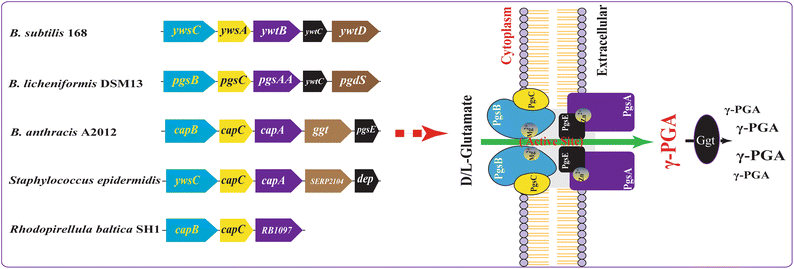Microbial synthesis of poly-γ-glutamic acid: current progress, challenges, and future perspectives
- PMID: 27366207
- PMCID: PMC4928254
- DOI: 10.1186/s13068-016-0537-7
Microbial synthesis of poly-γ-glutamic acid: current progress, challenges, and future perspectives
Abstract
Poly-γ-glutamic acid (γ-PGA) is a naturally occurring biopolymer made from repeating units of l-glutamic acid, d-glutamic acid, or both. Since some bacteria are capable of vigorous γ-PGA biosynthesis from renewable biomass, γ-PGA is considered a promising bio-based chemical and is already widely used in the food, medical, and wastewater industries due to its biodegradable, non-toxic, and non-immunogenic properties. In this review, we consider the properties, biosynthetic pathway, production strategies, and applications of γ-PGA. Microbial biosynthesis of γ-PGA and the molecular mechanisms regulating production are covered in particular detail. Genetic engineering and optimization of the growth medium, process control, and downstream processing have proved to be effective strategies for lowering the cost of production, as well as manipulating the molecular mass and conformational/enantiomeric properties that facilitate screening of competitive γ-PGA producers. Finally, future prospects of microbial γ-PGA production are discussed in light of recent progress, challenges, and trends in this field.
Keywords: Industrial applications; Metabolic regulation; Microbial fermentation; Poly-γ-glutamic acid; Process optimization; Strain development.
Figures


Similar articles
-
Genetic and metabolic engineering for microbial production of poly-γ-glutamic acid.Biotechnol Adv. 2018 Sep-Oct;36(5):1424-1433. doi: 10.1016/j.biotechadv.2018.05.006. Epub 2018 May 28. Biotechnol Adv. 2018. PMID: 29852203 Review.
-
Poly-γ-glutamic acid: production, properties and applications.Microbiology (Reading). 2015 Jan;161(Pt 1):1-17. doi: 10.1099/mic.0.081448-0. Epub 2014 Oct 6. Microbiology (Reading). 2015. PMID: 25288645 Review.
-
Recent Advances in Microbial Synthesis of Poly-γ-Glutamic Acid: A Review.Foods. 2022 Mar 2;11(5):739. doi: 10.3390/foods11050739. Foods. 2022. PMID: 35267372 Free PMC article. Review.
-
Poly-gamma-glutamic acid biopolymer: a sleeping giant with diverse applications and unique opportunities for commercialization.Biomass Convers Biorefin. 2023;13(6):4555-4573. doi: 10.1007/s13399-021-01467-0. Epub 2021 Apr 1. Biomass Convers Biorefin. 2023. PMID: 33824848 Free PMC article. Review.
-
Building a circular economy around poly(D/L-γ-glutamic acid)- a smart microbial biopolymer.Biotechnol Adv. 2022 Dec;61:108049. doi: 10.1016/j.biotechadv.2022.108049. Epub 2022 Oct 13. Biotechnol Adv. 2022. PMID: 36243207 Review.
Cited by
-
Genetic and metabolic engineering for poly-γ-glutamic acid production: current progress, challenges, and prospects.World J Microbiol Biotechnol. 2022 Aug 28;38(11):208. doi: 10.1007/s11274-022-03390-6. World J Microbiol Biotechnol. 2022. PMID: 36030456 Review.
-
Brown Algae as a Valuable Substrate for the Cost-Effective Production of Poly-γ-Glutamic Acid for Applications in Cream Formulations.Polymers (Basel). 2024 Jul 22;16(14):2091. doi: 10.3390/polym16142091. Polymers (Basel). 2024. PMID: 39065408 Free PMC article.
-
Editorial: chemicals and bioproducts from biomass.Biotechnol Biofuels. 2016 Oct 31;9:233. doi: 10.1186/s13068-016-0637-4. eCollection 2016. Biotechnol Biofuels. 2016. PMID: 27822306 Free PMC article. No abstract available.
-
Density and temperature controlled fluid extraction in a bacterial biofilm is determined by poly-γ-glutamic acid production.NPJ Biofilms Microbiomes. 2022 Dec 17;8(1):98. doi: 10.1038/s41522-022-00361-5. NPJ Biofilms Microbiomes. 2022. PMID: 36528619 Free PMC article.
-
Poly (γ-Glutamic Acid) Promotes Enhanced Dechlorination of p-Chlorophenol by Fe-Pd Nanoparticles.Nanoscale Res Lett. 2018 Jul 24;13(1):219. doi: 10.1186/s11671-018-2634-y. Nanoscale Res Lett. 2018. PMID: 30043321 Free PMC article.
References
-
- Sanda F, Fujiyama T, Endo T. Chemical synthesis of poly-gamma-glutamic acid by polycondensation of gamma-glutamic acid dimer: synthesis and reaction of poly-gamma-glutamic acid methyl ester. J Polym Sci Polym Chem. 2001;39:732–741. doi: 10.1002/1099-0518(20010301)39:5<732::AID-POLA1045>3.0.CO;2-P. - DOI
-
- Hezayen FF, Rehm BH, Tindall BJ, Steinbuchel A. Transfer of Natrialba asiatica B1T to Natrialba taiwanensis sp. nov. and description of Natrialba aegyptiaca sp. nov., a novel extremely halophilic, aerobic, non-pigmented member of the Archaea from Egypt that produces extracellular poly(glutamic acid) Int J Syst Evol Microbiol. 2001;51:1133–1142. doi: 10.1099/00207713-51-3-1133. - DOI - PubMed
-
- Akagi T, Baba M, Akashi M. Preparation of nanoparticles by the self-organization of polymers consisting of hydrophobic and hydrophilic segments: potential applications. Polymer. 2007;48:6729–6747. doi: 10.1016/j.polymer.2007.08.038. - DOI
Publication types
LinkOut - more resources
Full Text Sources
Other Literature Sources

